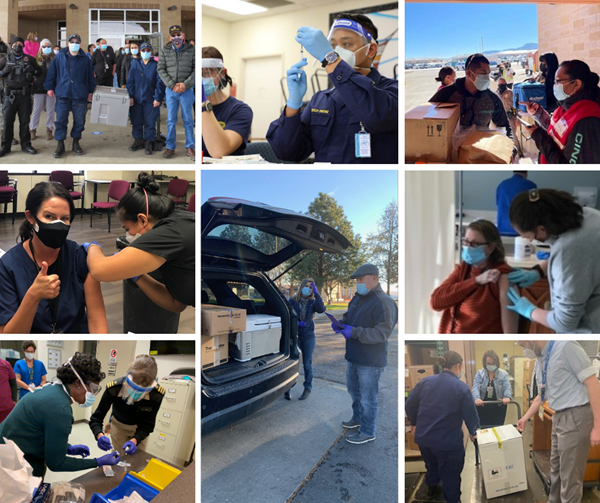
- Details
- By Jeannie Hovland
Hau Mitakuyepi, cante waste nape ciyuazape ksto. Hello, my relatives, I greet you with a good heart. As we enter a new year, I hope this message finds you and your family well.
This article was originally published by the blog for the Administration for Children and Families.
Tragically, the Coronavirus pandemic (COVID-19) has disproportionately affected American Indian and Alaska Native (AI/AN) populations. According to the Centers for Disease Control and Prevention (CDC) Week 51 COVIDView data, between March 1 to December 19, 2020, AI/AN people were 3-1/2 times more likely to be infected with the COVID-19 virus and over four times more likely to be hospitalized as a result of COVID-19. This is why I felt it so important to share how we can now begin to prevent this disease!
I have lost dear friends as a result of the COVID-19 and I hear from tribal leaders across the nation of how this pandemic continues to plague their communities. It’s heartbreaking to see this virus have such a traumatic effect on so many of our Native communities. We have lost many elders and family members. Communities are grieving and often unable to come together to provide comfort in person and participate in ceremonies. We are deeply concerned with the reality that, as we lose our elders, we also lose the most fluent speakers of our languages and knowledge of our traditional ways. This is why a vaccine, which can prevent further serious infection and harm, is especially welcomed in tribal communities.
 Commissioner Jeannie Hovland.
Commissioner Jeannie Hovland.
There are multiple COVID-19 vaccines under development. Currently, two vaccines are authorized and recommended to prevent COVID-19: the Pfizer-BioNTech COVID-19 vaccine Visit disclaimer page and Moderna’s COVID-19 vaccine. Both of these vaccines have shown to be both safe and effective as determined by data from their manufacturers Visit disclaimer page and findings from large clinical trials. The data demonstrates that the known and potential benefits of these vaccines far outweigh the known and potential harmful effects of becoming infected with COVID-19. If you have questions about the vaccine, check with your primary care doctor or health provider, but please don’t let fear of the unknown guide your decisions about this vaccine.
I have had the honor to work with Indian Health Service Director, Rear Admiral Michael D. Weahkee, for over five years and am continually impressed and grateful for his leadership including his work on Operation Warp Speed Visit disclaimer page . Rear Adm. Weahkee continues to ensure that tribes are heard and given priority when his agency conveys vital information and services available, which was especially critical during this pandemic.
“The Indian Health Service has been at the table since day one as part of HHS’ pandemic response team and ensuring that the concerns of tribal leaders and urban Indian health care recipients are heard,” said IHS Director Rear Adm. Michael D. Weahkee. “The Indian Health Service (IHS) is committed to equitable and timely vaccine distribution and administration to our patients, workforce and our communities. We are working with our partners at national and local levels to broaden our message of vaccine safety and efficacy, promoting vaccine acceptance while respecting the cultural and historical concerns.”
Ensuring vaccine safety is a top priority, and vaccination is paramount to safety in this COVID-19 pandemic. The vaccine’s benefits include preventing severe COVID-19 and helping to build your body’s immunity to fight off the virus. The CDC offers an in-depth website (8 Things to Know about the U.S. COVID-19 Vaccination Program Visit disclaimer page ) that can help you better understand the COVID-19 virus and the vaccine. This information includes who will be getting the vaccine first and how you can continue to stay safe and reduce the spread.
Even with the many uncertainties that have come with this global pandemic, I remain hopeful. I believe the best way we can combat this virus is with the COVID-19 vaccine! I encourage you to share this blog with your loved ones and please educate others about the importance of getting vaccinated. I know our strength as Native people - our warrior spirit and resiliency.
Jeannie Hovland, an enrolled member of the Flandreau Santee Sioux Tribe of South Dakota, is the Commissioner of the Administration for Native Americans (ANA), an agency within the U.S. Department of Health and Human Services.
Help us defend tribal sovereignty.
At Native News Online, our mission is rooted in telling the stories that strengthen sovereignty and uplift Indigenous voices — not just at year’s end, but every single day.
Because of your generosity last year, we were able to keep our reporters on the ground in tribal communities, at national gatherings and in the halls of Congress — covering the issues that matter most to Indian Country: sovereignty, culture, education, health and economic opportunity.
That support sustained us through a tough year in 2025. Now, as we look to the year ahead, we need your help right now to ensure warrior journalism remains strong — reporting that defends tribal sovereignty, amplifies Native truth, and holds power accountable.
 The stakes couldn't be higher. Your support keeps Native voices heard, Native stories told and Native sovereignty defended.
The stakes couldn't be higher. Your support keeps Native voices heard, Native stories told and Native sovereignty defended.
Stand with Warrior Journalism today.
Levi Rickert (Potawatomi), Editor & Publisher
